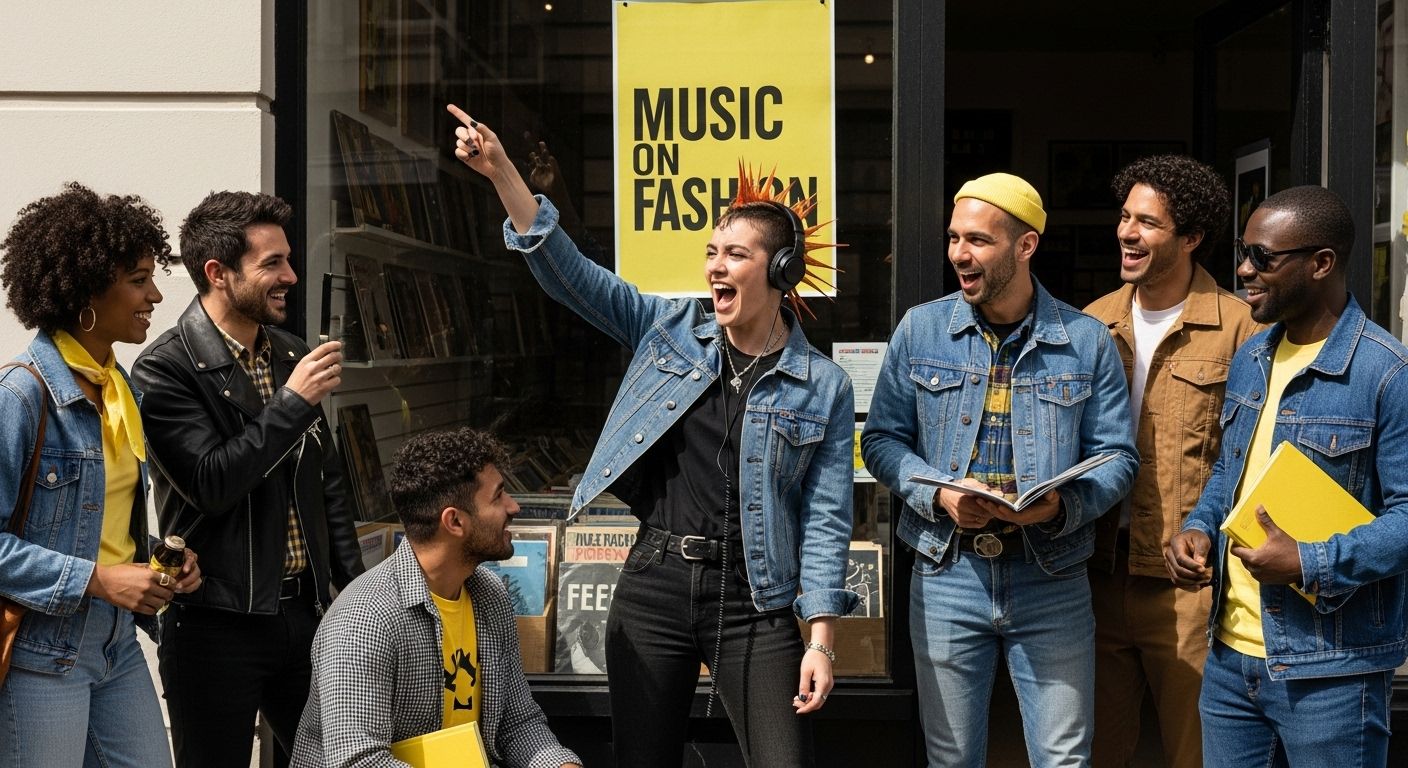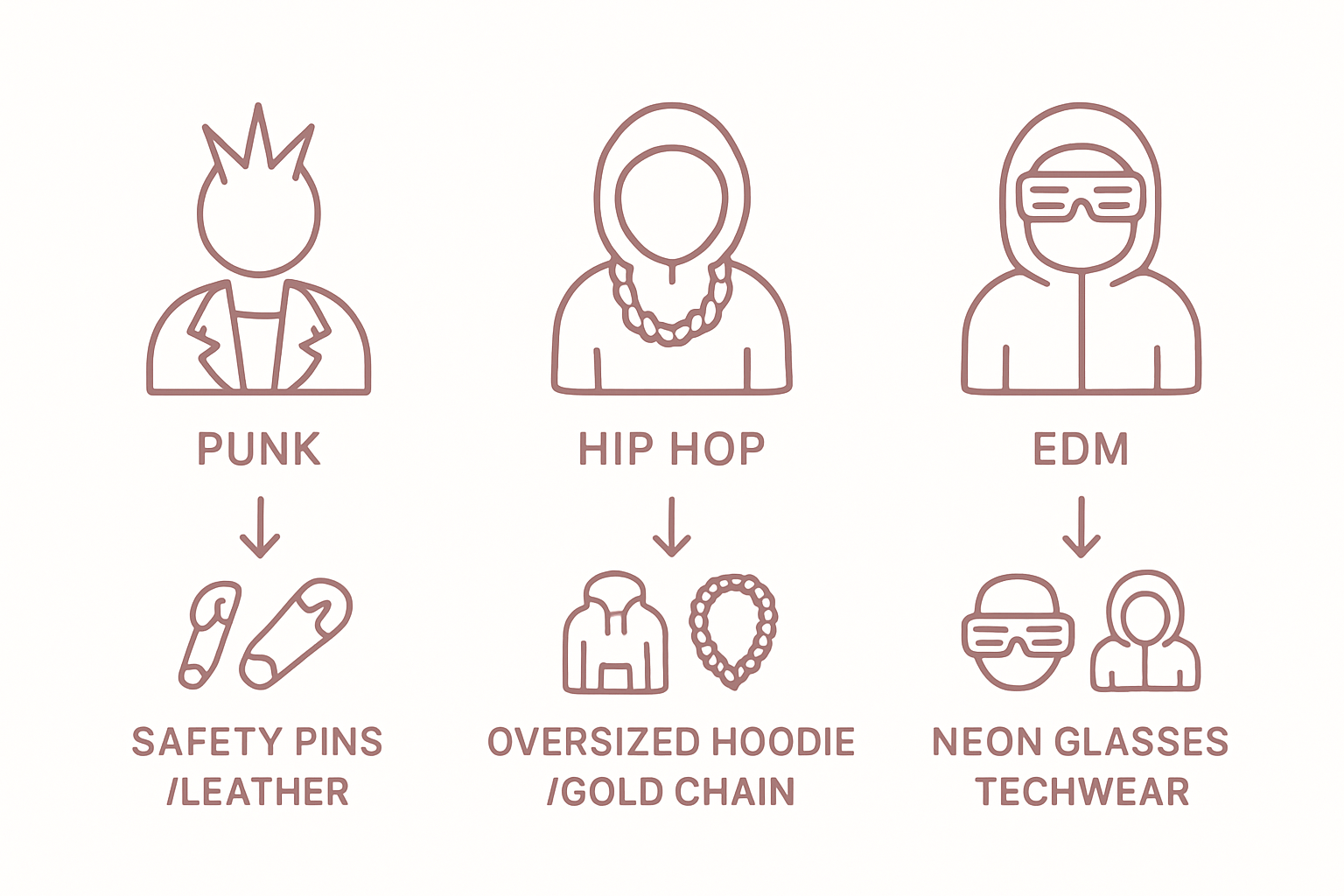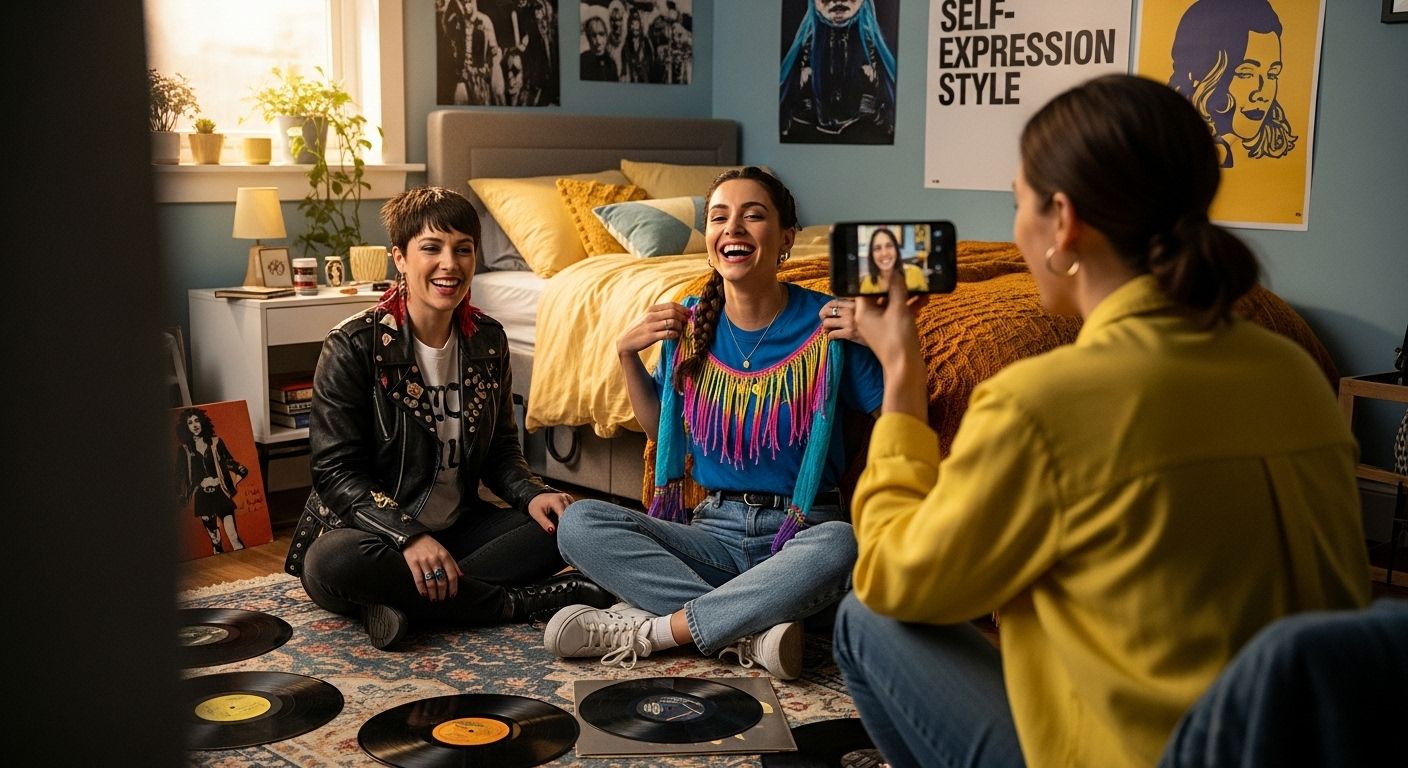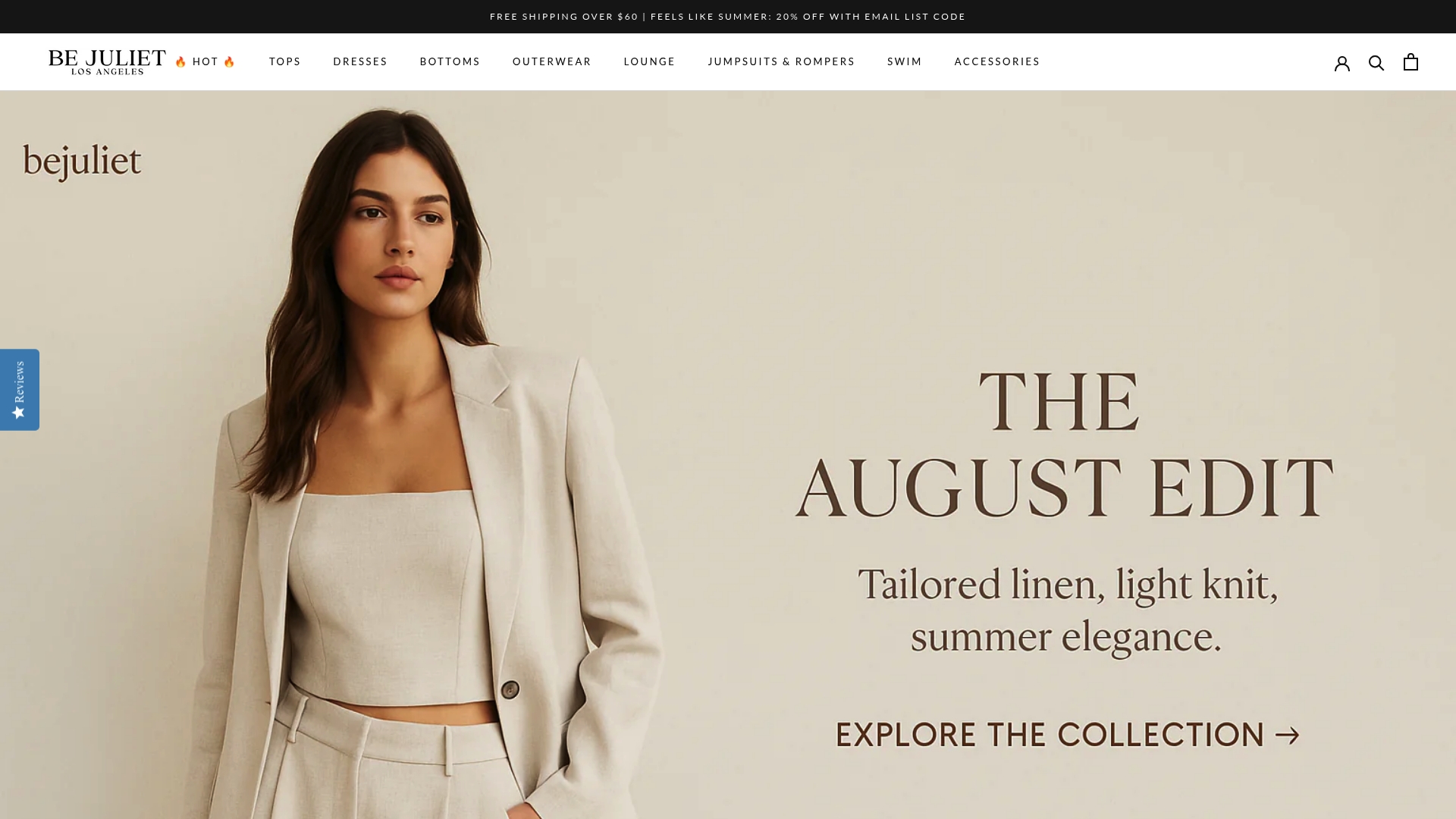Understanding the Influence of Music on Fashion
Music shapes more than just playlists, it transforms what people wear and how entire generations express themselves.

Think about this, trends like hip hop inspired oversized streetwear and punk’s DIY looks started with musicians, then took over global fashion. Most people assume runway designers are the trendsetters, but it’s the soundtracks of our lives that rewrite the rules of style.
Table of Contents
- The Role Of Music In Shaping Fashion Trends
- Cultural Movements And Their Fashion Statements
- Icons And Their Impact On Fashion Choices
- The Interaction Of Music Genres And Style
- How Music Festivals Transform Fashion Scenes
Quick Summary
| Takeaway | Explanation |
|---|---|
| Music influences fashion trends significantly. | Musical genres shape distinct styles, transforming clothing into cultural expressions and identities. |
| Fashion reflects cultural movements and resistance. | Clothing communicates social messages, expressing rebellion and identity through unique styles across subcultures. |
| Icons redefine fashion through personal aesthetics. | Musicians like Madonna and Billie Eilish use fashion as a tool for self-expression, challenging traditional norms. |
| Festivals foster innovative fashion experimentation. | Music festivals create vibrant spaces for personal style to thrive, influencing global trends and creative expression. |
| Genre-specific aesthetics shape personal identity. | The visual languages of music genres inform personal style choices, connecting musical preferences with everyday fashion. |
The Role of Music in Shaping Fashion Trends
Music and fashion share an intricate, symbiotic relationship that transcends mere aesthetic expression. This dynamic connection reveals how musical genres, artists, and cultural movements profoundly influence sartorial choices and style evolution.
Musical Genres as Cultural Catalysts
Each musical genre carries its unique visual language, transforming clothing into a powerful form of cultural communication. According to the Smithsonian Institution, musicians often establish signature looks that become emblematic of entire movements. Rock music introduced leather jackets and rebellious denim, punk celebrated DIY aesthetic with safety pins and torn clothing, while hip hop popularized oversized streetwear and bold urban styles.

Artist Influence and Style Archetypes
Iconic musicians have consistently redefined fashion boundaries. Artists like Madonna revolutionized feminine fashion through provocative costume changes, while Beyoncé elevated cultural statements through her wardrobe. Contemporary artists such as Billie Eilish challenge traditional gender fashion norms, demonstrating how musical personalities can reshape societal style perceptions.
Musical fashion influence extends beyond clothing, creating entire lifestyle aesthetics:
- Punk rock: Anti establishment rebellion
- Hip hop: Urban street credibility
- Electronic dance music: Futuristic experimental styles
For those curious about emerging fashion trends, explore our guide on contemporary style inspirations.
The relationship between music and fashion remains dynamic, continuously evolving with cultural shifts and artistic expressions. What begins as a niche musical subculture can rapidly transform into global fashion trends, proving that music is not just heard but also worn.
To clarify how different musical genres have shaped fashion, here is a table summarizing each genre’s signature style and cultural impact:
| Musical Genre | Signature Fashion Elements | Cultural Message/Impact |
|---|---|---|
| Rock | Leather jackets, denim, band t-shirts | Rebellion, authenticity, nonconformity |
| Punk | DIY clothing, safety pins, ripped garments | Anti-establishment, creative resistance |
| Hip Hop | Oversized streetwear, bold logos, sneakers | Urban authenticity, cultural pride |
| Electronic Dance Music | Futuristic, metallic, neon styles | Innovation, boundary-pushing, experimental spirit |
| Indie Folk | Vintage layers, earthy tones, bohemian accessories | Individualism, handcrafted values, counterculture |
| Goth | Black, dramatic silhouettes, heavy accessories | Emotional depth, mainstream rejection |
Cultural Movements and Their Fashion Statements
Cultural movements represent more than political ideologies or social change—they are powerful visual narratives expressed through clothing, style, and personal aesthetic choices. Fashion becomes a profound language of rebellion, identity, and collective expression.
Fashion as Social Resistance
Throughout history, clothing has been a critical medium for challenging societal norms and communicating resistance. The hippie movement of the 1960s, for instance, rejected mainstream conservative fashion with vibrant, unconventional styles that symbolized peace, freedom, and counterculture. Bell-bottom jeans, tie-dye shirts, and long hair became powerful statements against established social structures.
Subcultures and Distinctive Style Vocabularies
Each subculture develops a unique sartorial dialect that communicates complex social messages. According to research from KCPR, these style languages extend far beyond simple clothing choices:
Here is a table outlining the characteristic fashion languages of major subcultures, providing a quick reference to understand how style communicates deep cultural messages:
| Subculture | Key Fashion Elements | Social/Cultural Meaning |
|---|---|---|
| Punk | Leather jackets, safety pins, torn clothing | Anti-establishment sentiment |
| Goth | Dark, dramatic clothing | Emotional depth, rejection of mainstream |
| Hip Hop | Oversized clothing, athletic wear, bold logos | Urban authenticity, cultural pride |
| Hippie | Bell-bottoms, tie-dye, long hair | Peace, freedom, counterculture rebellion |
- Punk: Leather jackets, safety pins, torn clothing signaling anti establishment sentiment
- Goth: Dark, dramatic clothing representing emotional depth and rejection of mainstream aesthetics
- Hip hop: Oversized clothing representing urban authenticity and cultural pride
Contemporary Cultural Fashion Statements
In the digital age, cultural movements leverage fashion as a global communication tool. Contemporary movements like body positivity, gender fluidity, and sustainability have transformed fashion into platforms for social dialogue. Discover more about innovative style trends that challenge traditional fashion narratives.
Fashion remains a dynamic, powerful medium where personal style intersects with broader cultural narratives, continuously redefining social boundaries and individual expression.
Icons and Their Impact on Fashion Choices
Musical icons transcend mere performance, emerging as transformative cultural architects who reshape fashion landscapes through their distinctive personal styles and bold aesthetic statements. Their influence extends far beyond music, creating powerful visual narratives that inspire global fashion movements.
Pioneering Style Revolutionaries
Certain musicians have become legendary for their revolutionary fashion choices. According to the Smithsonian Institution, artists like Prince, David Bowie, and Madonna deliberately used clothing as a form of artistic expression, challenging societal norms and expanding perceptions of gender, sexuality, and personal identity.
Musical Genres and Style Archetypes
Each musical genre cultivates its unique aesthetic language, with icons serving as primary style ambassadors:
- Rock: Leather jackets, ripped denim, rebellious attitude
- Hip hop: Oversized streetwear, bold logos, urban authenticity
- Electronic: Futuristic, minimalist, tech-inspired designs
- Indie: Vintage, eclectic, thrifted aesthetic
Contemporary Fashion Iconography
Modern musical icons continue to redefine fashion boundaries. Artists like Billie Eilish challenge traditional gender fashion norms with oversized, androgynous styling, while Rihanna has transformed her musical career into a comprehensive fashion and beauty empire. Learn more about personal style empowerment and how musical icons inspire individual expression.
These cultural influencers demonstrate that fashion is not just about clothing—it is a powerful medium of communication, rebellion, and personal storytelling, with music serving as its most dynamic catalyst.
The Interaction of Music Genres and Style
Music genres represent more than sonic experiences—they are complex cultural ecosystems that generate distinctive visual languages, transforming fashion into a profound form of cultural expression and identity communication.
Sonic Aesthetics and Visual Representation
Each musical genre develops a unique aesthetic vocabulary that extends beyond sound into visual territories. According to research from the National Library of Medicine, our musical preferences fundamentally influence our personal appearance and style choices, creating intricate connections between sonic experiences and visual representations.
Genre Specific Style Manifestations
Different musical genres cultivate specific style archetypes that reflect their core cultural philosophies:
- Rock: Rebellion through distressed leather, band t-shirts, and raw, unpolished aesthetics
- Hip Hop: Urban authenticity expressed via oversized silhouettes, bold logos, and street-inspired layering
- Electronic Dance Music: Futuristic minimalism with metallic textures, neon accents, and tech-inspired designs
- Indie Folk: Vintage romanticism featuring earthy tones, handcrafted elements, and bohemian layering
Psychological Dimensions of Musical Style
Beyond visual representation, musical genres impact psychological perceptions and consumer behaviors. Explore the deeper connections between personal style and musical identity, revealing how our sonic preferences shape not just what we wear, but how we perceive ourselves and interact with the world.
The relationship between music and fashion remains a dynamic, ever-evolving dialogue—a continuous conversation where sound and style dance together, creating powerful narratives of cultural identity and personal expression.
How Music Festivals Transform Fashion Scenes
Music festivals have evolved from mere concert experiences into powerful cultural laboratories where fashion becomes a dynamic, experimental playground of self-expression, creativity, and collective identity.
Festival Fashion as Cultural Phenomenon
Modern music festivals represent more than musical events—they are immersive environments where style becomes a performative art form. According to research exploring festival culture, these gatherings serve as transformative spaces where personal style transcends traditional boundaries.
Aesthetic Expressions and Style Tribes
Each music festival cultivates its distinctive aesthetic ecosystem, creating unique style manifestations:
- Coachella: Bohemian desert chic with flowy fabrics, fringe details, and eclectic accessories
- Burning Man: Futuristic, cyberpunk-inspired designs with metallic textures and experimental silhouettes
- Tomorrowland: Electronic music-inspired fashion featuring neon colors, tech-influenced materials, and avant-garde performance wear
- Glastonbury: Indie folk and rock aesthetic with vintage layers, sustainable fabrics, and counterculture influences
Digital Age and Global Style Inspiration
In the contemporary landscape, music festivals have become global style incubators, rapidly disseminating trends through social media platforms. Discover emerging fashion inspirations that challenge traditional style narratives and celebrate individual creativity.
These musical gatherings demonstrate that fashion is not just about clothing—it is a profound language of cultural exchange, personal storytelling, and collective imagination.
Elevate Your Style With the Rhythm of Self-Expression
Are you inspired by how music shapes fashion, yet find it hard to translate that energy into your own wardrobe? The journey to authentic self-expression, highlighted in our article, shows many women longing for styles that echo the boldness seen at music festivals and the confidence found in your favorite artists. Too often, mainstream fashion offers cookie-cutter options that miss the passion and freedom at the heart of music-driven trends.
At Be Juliet, we believe fashion should empower you to celebrate your individuality and mood, just like a powerful song does. Whether you seek the rebellious edge of rock, the relaxed feel of indie, or the statement-making flair of festival style, our collections are designed to let your unique vibe shine. No matter the occasion or your mood, you will find standout pieces that embrace comfort, beauty, and confidence.


Ready to wear what moves you? Experience the liberating fusion of music and fashion by exploring our inspired pieces. Visit Be Juliet now and start curating your own iconic look today. For even more inspiration on current trends and statement pieces, dive into our resources on contemporary style inspirations and understanding statement pieces in fashion. Now is the perfect moment to amplify your style and celebrate every part of yourself.
Frequently Asked Questions
How does music influence fashion trends?
Music influences fashion trends by shaping cultural movements and establishing unique visual languages associated with different musical genres, which then translate into distinctive clothing styles.
What role do musicians play in fashion?
Musicians act as cultural icons who redefine fashion boundaries, often using their personal style as a form of artistic expression that influences global fashion movements and societal perceptions.
How do cultural movements affect fashion styles?
Cultural movements impact fashion by using clothing as a medium for rebellion and identity expression, creating distinctive styles that reflect the values and aesthetics of the movement.
What are examples of musical genres that have influenced fashion?
Genres like rock, punk, hip hop, and electronic dance music have all significantly influenced fashion, each cultivating its unique aesthetic and style archetypes that resonate with broader cultural philosophies.
Recommended
-
[ Understanding Current Fashion Trends 2025: A Deep Dive
– Be Juliet](https://bejuliet.com/blogs/blog/understanding-current-fashion-trends)
-
[ Understanding Empowerment Through Fashion: A Woman’s Guide
– Be Juliet](https://bejuliet.com/blogs/blog/understanding-empowerment-through-fashion)
-
[ Fashion and Mental Health: How Your Style Impacts Your Wellbeing
– Be Juliet](https://bejuliet.com/blogs/blog/fashion-and-mental-health-how-your-style-impacts-your-wellbeing)
-
[ Understanding the Difference Between Fashion and Style
– Be Juliet](https://bejuliet.com/blogs/blog/difference-between-fashion-and-style)
